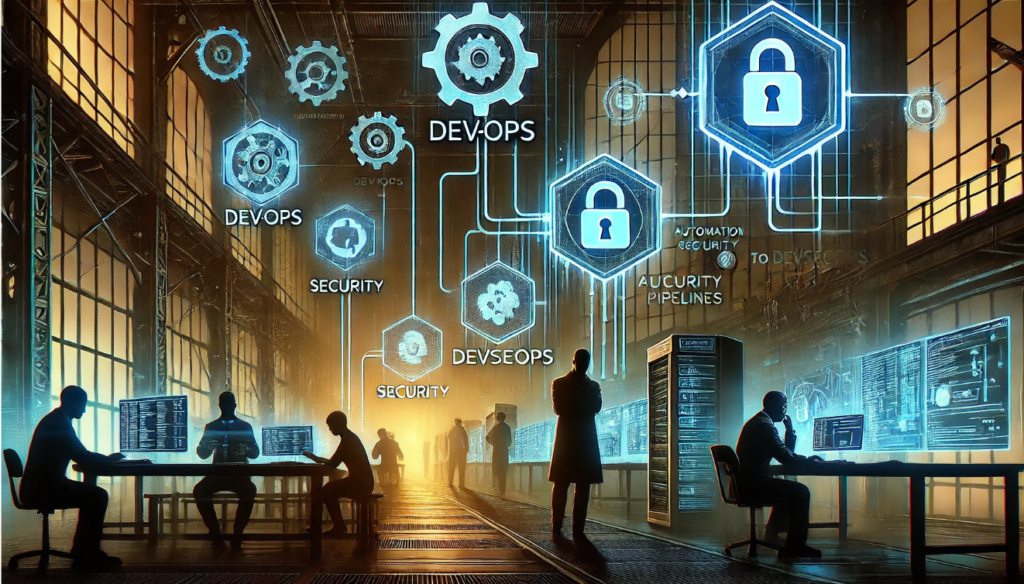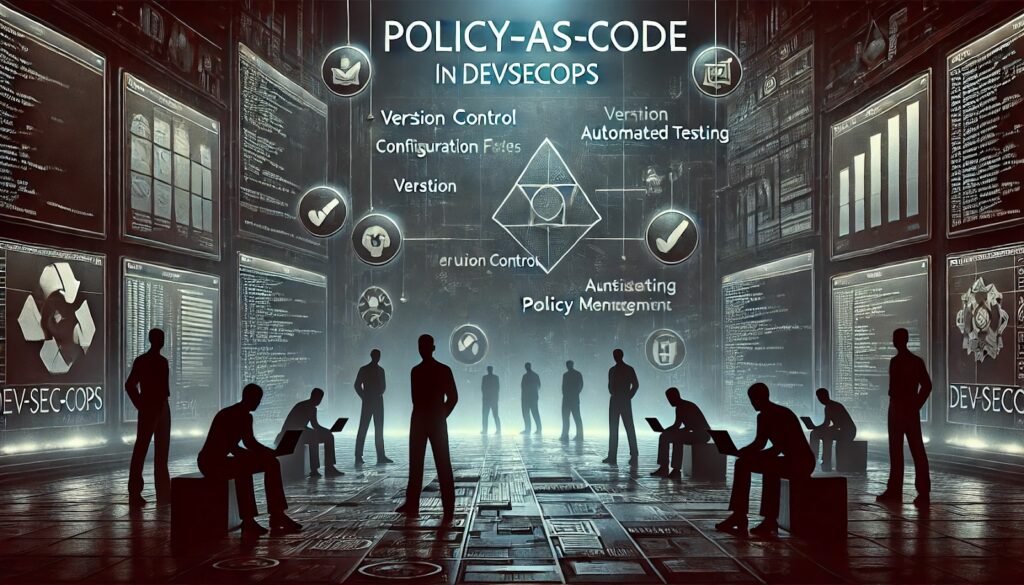DevSecOps strategies, tools & best practices

Shifting from traditional DevOps to DevSecOps is a proactive response to these challenges, embedding security into the development process right from the start. This approach—often referred to as “shift-left”—enables teams to catch and address vulnerabilities early in the software development lifecycle, promoting a culture of shared responsibility.
This guide is your roadmap to implementing DevSecOps effectively. It’s packed with practical strategies, tool suggestions, and real-world insights tailored to help you strengthen your security stance while aligning with your business goals and compliance needs.
Implementing DevSecOps: Strategies, tools, and best practices for DevOps security — you are here
Understanding DevOps security and compliance
What Is DevSecOps?
DevSecOps, short for Development, Security, and Operations, represents a natural progression of the traditional DevOps framework, placing a strong emphasis on integrating security at every stage of the software development lifecycle (SDLC).
Unlike conventional approaches where security often takes a backseat or is siloed within a specific team, DevSecOps weaves security practices into the entire process—from initial design through to deployment and ongoing maintenance.
This seamless integration ensures quicker identification and resolution of security vulnerabilities, perfectly aligning with the fast-paced nature of Agile and DevOps methodologies.
The transition from DevOps to DevSecOps
Shifting from DevOps to DevSecOps introduces several key transformations:
- Cultural shift. Security evolves into a shared responsibility, involving all team members rather than being confined to the security team.
- Automation. Security tasks are automated within the CI/CD pipeline, facilitating continuous compliance without compromising development speed.
- Integration. Security tools and practices blend naturally into existing workflows, allowing for real-time assessments and rapid remediation of vulnerabilities.

Shared responsibility model
In DevSecOps, security isn’t just the concern of a specialized group; it’s a collective effort across development, operations, and security teams. This collaborative model cultivates a security-first mindset, empowering teams to build stronger, more resilient systems while proactively addressing risks throughout the development process.
Importance of compliance in DevOps
Overview of critical compliance standards
Maintaining compliance with industry regulations is not just about avoiding penalties; it’s about safeguarding sensitive information and maintaining trust with users. Key standards include:
- GDPR (General data protection regulation). Focuses on data protection and privacy for individuals within the European Union.
- HIPAA (Health insurance portability and accountability act). Ensures the protection of sensitive patient health information in the United States.
- PCI DSS (Payment card industry data security standard). Sets forth security requirements for companies handling credit card transactions.
Role of compliance in DevSecOps
Integrating compliance within DevSecOps goes beyond meeting legal obligations; it strengthens security practices and enhances data protection. The benefits include:
- Automated compliance checks. Tools continuously validate adherence to relevant standards, seamlessly embedded into the SDLC.
- Enhanced data protection. By incorporating robust security measures, sensitive data is better protected against breaches.
- Building user trust. Demonstrating compliance builds confidence among users and stakeholders, showing that security and privacy are prioritized.
Embedding compliance into day-to-day workflows helps organizations streamline their operations, avoid legal pitfalls, and maintain a strong security posture.
Glossary of terms and acronyms
- DevSecOps — development, security, and operations; an approach that integrates security into every phase of the SDLC.
- CI/CD — continuous integration/continuous deployment; processes that automate the building, testing, and deployment of software.
- GDPR — general data protection regulation; EU legislation governing data protection and privacy.
- HIPAA — Health Insurance Portability and Accountability Act; U.S. regulation protecting health information.
- PCI DSS — payment card industry data security standard; guidelines for securing credit card data.
- SAST — static application security testing; examines source code for vulnerabilities without executing it.
- DAST — dynamic application security testing; evaluates running applications to identify vulnerabilities in real-time.
- Security-as-code — the practice of managing security policies and controls as code, enabling consistency and automation across environments.
Latest trends and future outlook in DevSecOps

Emerging technologies
The DevSecOps landscape is evolving rapidly, fueled by technologies that bolster security and streamline software development. Key trends driving this evolution include:
Automation and AI integration
Automation remains a cornerstone of DevSecOps, with Artificial Intelligence (AI) playing an increasingly prominent role in enhancing security processes. Tools for automated vulnerability scanning, code analysis, and continuous monitoring are becoming standard, and AI augments these capabilities by enabling early detection and resolution of security issues. This allows security teams to focus on strategic priorities rather than manual tasks, boosting overall efficiency.
Infrastructure as code (IaC)
IaC is transforming infrastructure management by allowing teams to define and manage resources through code. This approach facilitates automated deployments and maintains consistency across environments. By embedding security practices within IaC, organizations can minimize the risk of misconfigurations, ensuring security is integral to infrastructure management.
Cloud-native security
As businesses increasingly adopt cloud-native architectures, securing these dynamic environments has become essential. Specialized security tools tailored for containers, serverless functions, and microservices help manage the complexities and risks associated with cloud scalability. Cloud-native security practices are crucial for protecting these ever-evolving infrastructures.
Shift-left security
The shift-left approach emphasizes integrating security early in the software development lifecycle, starting at the design phase and continuing through development. This proactive strategy allows teams to identify vulnerabilities before they escalate into major issues. Organizations are increasingly focusing on training developers in secure coding to support this early-stage security integration.
Threat intelligence and analytics
Utilizing threat intelligence enables organizations to anticipate risks by analyzing data patterns and anomalies. Incorporating threat intelligence into DevSecOps workflows enhances proactive risk management, equipping teams to respond swiftly to emerging threats and maintain a strategic edge over attackers.
Future predictions
Looking ahead, several key predictions are shaping the future of DevSecOps:
Increased emphasis on security automation
As cyber threats become more sophisticated, the role of automation in maintaining robust security measures will continue to grow. Organizations are expected to rely more on automated tools for ongoing security assessments within CI/CD pipelines, allowing vulnerabilities to be addressed quickly without slowing down development.
Cultural transformation
The success of DevSecOps will depend heavily on cultivating a culture of collaboration between development, operations, and security teams. Investing in training programs that encourage shared responsibility for security across all organizational levels will help dismantle silos and improve communication.
Integration of advanced technologies
Emerging technologies like quantum computing and blockchain are anticipated to impact DevSecOps practices. While these innovations offer substantial security benefits, they also introduce new challenges that organizations will need to address with care.
DevSecOps as standard practice
Security is expected to become an embedded aspect of the software development lifecycle rather than an afterthought. The seamless integration of security tools into CI/CD pipelines will facilitate real-time vulnerability assessments and compliance checks during regular development activities.
Focus on compliance automation
In response to growing regulatory demands, automating compliance checks will become increasingly vital. Organizations will evolve their CI/CD pipelines to include compliance as a core component, ensuring adherence to standards without hindering development speed.
Key strategies for integrating security into DevOps
Shift-left security: Early integration
Adopting a shift-left security approach involves integrating security measures at the earliest stages of the software development lifecycle (SDLC). This proactive strategy brings several key benefits:
- Cost reduction. Addressing security vulnerabilities early in the development process significantly reduces the costs associated with fixing issues later on.
- Improved software quality. Early identification and resolution of security flaws enhance the overall quality, performance, and reliability of software products.
- Faster time to market. Streamlined security processes allow for quicker development cycles, facilitating faster releases without sacrificing security standards.
- Enhanced collaboration. Incorporating security from the beginning fosters better teamwork between development, operations, and security teams, creating a culture of shared responsibility.
Implementation methods
Organizations can effectively implement shift-left security by adopting the following methods:
- Automated security testing. Integrate tools like Static Application Security Testing (SAST) and Dynamic Application Security Testing (DAST) into CI/CD pipelines to continuously assess code and dependencies for vulnerabilities.
- Threat modeling. Conduct threat modeling sessions during the design phase to identify potential vulnerabilities and attack vectors, allowing for proactive risk mitigation.
- Secure coding practices. Offer training programs for developers focused on secure coding techniques to ensure they write code that minimizes vulnerabilities from the start.
Continuous security monitoring and automated testing
Continuous security monitoring is vital for maintaining a robust security posture throughout the SDLC. This practice involves real-time assessment and analysis of security events, enabling organizations to detect and respond to threats swiftly. Continuous monitoring not only ensures ongoing compliance with regulatory requirements but also strengthens incident response capabilities.
Key tools
To support continuous security monitoring and automated testing, organizations can leverage the following tools:
- Automated security testing tools. Use SAST and DAST solutions to perform automated scans of codebases during both the development and deployment phases, identifying vulnerabilities quickly.
- Security information and event management (SIEM). Deploy SIEM platforms to aggregate and analyze security data from across the organization, providing real-time monitoring and enhancing incident response times.
- Vulnerability management platforms. Utilize platforms that continuously identify, prioritize, and remediate vulnerabilities within applications and infrastructure, keeping security measures up-to-date.
Compliance automation and policy-as-code
Automating compliance checks
Automating compliance checks is essential for meeting regulatory requirements without slowing down development. By embedding compliance verification into CI/CD pipelines, teams can catch non-compliant configurations early in the development process, accelerating compliance validation and reducing the risk of costly penalties.
Policy-as-code

Policy-as-code involves defining compliance requirements through code, using configuration files, automation scripts, or infrastructure templates. This approach ensures that policies are consistently enforced across all environments. Key benefits include:
- Version control. Managing policies as code allows teams to track changes over time using version control systems, providing a clear audit trail of policy updates.
- Automated testing. Policies can be tested automatically within CI/CD workflows to ensure they work as intended before deployment, minimizing the risk of errors.
- Consistency. Programmatic enforcement of policies reduces human error and ensures compliance is maintained uniformly throughout the organization.
Metrics and KPIs for measuring the success of DevOps security
Defining success metrics
To measure the success of DevOps security, it’s essential to establish clear metrics and key performance indicators (KPIs) that capture the effectiveness of security practices throughout the software development lifecycle (SDLC). Here are key metrics that provide valuable insights:
- Mean time to detect (MTTD). This metric tracks the average time taken to identify security incidents or vulnerabilities. A lower MTTD reflects more efficient monitoring and faster detection capabilities, allowing teams to respond promptly to potential threats.
- Mean time to remediate (MTTR). MTTR measures the average time required to address identified vulnerabilities. Reducing MTTR is vital for minimizing the impact of security breaches and ensuring quick resolution, enhancing the overall security posture.
- Security vulnerabilities number. Monitoring the total number of vulnerabilities discovered during development helps organizations assess their security health. It provides insights into trends, highlights areas needing attention, and helps prioritize remediation efforts.
- Security test coverage. This metric evaluates the extent of code covered by automated security tests, indicating how thoroughly security practices are integrated into the development workflow. Higher coverage suggests more comprehensive protection against potential threats.
- Compliance audit scores. Regular audits against standards such as GDPR or HIPAA gauge how well security practices align with regulatory requirements. High scores indicate effective compliance measures, while lower scores highlight areas needing improvement.
- Deployment frequency. Tracking deployment frequency helps correlate security practices with release cycles, ensuring that robust security measures do not compromise development speed. High frequency with maintained security standards demonstrates a mature DevSecOps environment.
By defining and regularly monitoring these metrics, organizations can evaluate the effectiveness of their security initiatives, pinpoint areas for improvement, and make data-driven decisions to enhance their security strategies.
Monitoring tools
To effectively track and analyze these metrics, integrating appropriate monitoring tools within DevOps workflows is essential. Here are some key tools that support continuous security measurement:
- Static application security testing (SAST). SAST tools analyze source code for vulnerabilities before deployment, offering early detection capabilities. Popular tools include Checkmarx and SonarQube, which help identify security flaws at the code level.
- Dynamic application security testing (DAST). DAST tools evaluate running applications to identify vulnerabilities that manifest during execution. Tools like OWASP ZAP and Burp Suite provide insights into real-time security threats within operational environments.
- Security information and event management (SIEM). SIEM solutions collect and analyze security data from across the organization, supporting real-time monitoring and rapid incident response. Platforms like Splunk and LogRhythm enhance visibility and facilitate proactive threat management.
- Continuous integration/continuous deployment (CI/CD) tools. Integrating security checks within CI/CD pipelines automates testing and monitoring processes. Tools like Jenkins, GitLab CI, and CircleCI can be equipped with security plugins, ensuring that best practices are consistently enforced.
- Vulnerability management platforms. These platforms track vulnerabilities across applications and infrastructure, prioritizing remediation based on risk. Qualys and Tenable.io are examples that help manage vulnerabilities effectively and enhance overall security hygiene.
- Compliance automation tools. Automating compliance checks ensures that regulatory requirements are met throughout the development process. Solutions like Drata and Vanta simplify compliance verification, reducing manual effort and supporting continuous adherence.
DevSecOps best practices for secure development
Implementing DevSecOps effectively involves combining strategies that prioritize secure coding, proactive incident response, and stringent secrets management. By embracing these best practices, organizations can strengthen their security throughout the software development lifecycle while fostering a culture of shared responsibility.
Secure coding practices and vulnerability management

Secure coding is the foundation of a resilient application. Establishing clear guidelines based on industry standards like the OWASP Top Ten helps address critical areas such as:
- Input validation to prevent injection attacks.
- Output encoding to safeguard against cross-site scripting (XSS).
- Proper error handling to avoid information leaks.
- Strong authentication mechanisms to protect user credentials.
OWASP Top Ten security practices: A quick dive
Here’s a conversational guide to the OWASP Top Ten practices, detailing each issue and how you can protect your software against these threats.
1. Injection
Injection flaws happen when untrusted data is sent to an interpreter as part of a command or query. Attackers can manipulate this data to execute unintended commands or access unauthorized information.
How to prevent it: Use parameterized queries, prepared statements, and input validation. This ensures that user inputs don’t alter your intended commands, keeping the application secure.
2. Broken authentication
Incorrect implementation of authentication and session management can lead attackers to compromise passwords, keys, or session tokens, posing as other users.
How to prevent it: Strengthen your authentication processes with multi-factor authentication, secure password storage, and solid session management best practices. This will protect against unauthorized access and identity theft.
3. Sensitive data exposure
Applications often fail to properly protect sensitive data like personal, financial, or healthcare information. This can lead to identity theft, fraud, and other serious breaches.
How to prevent it: Encrypt sensitive data both at rest and in transit, use robust cryptographic algorithms, and ensure your key management practices are rock solid.
4. XML external entities (XXE)
Outdated or poorly configured XML processors can process external entity references within XML documents, potentially exposing internal files, enabling remote code execution, or launching denial-of-service attacks.
How to prevent it: Disable external entity processing in XML parsers, or better yet, switch to simpler data formats like JSON to reduce risk.
5. Broken access control
Weak access controls allow attackers to access unauthorized functionality or data, often because restrictions aren’t properly enforced.
How to prevent it: Enforce proper access control checks, apply the principle of least privilege, and deny access by default to keep unauthorized users out.
6. Security misconfiguration
Misconfiguration remains one of the most common security issues, often stemming from insecure default settings, incomplete setups, or unpatched systems.
How to prevent it: Create a secure configuration baseline, automate your configuration processes, and stay diligent about updating and patching your systems regularly.
7. Cross-site scripting (XSS)
XSS occurs when applications include untrusted data in web pages without proper validation or escaping, potentially allowing attackers to inject malicious scripts.
How to prevent it: Implement input validation, output encoding, and content security policies (CSP) to block these types of attacks effectively.
8. Insecure deserialization
Insecure deserialization happens when applications deserialize untrusted data without proper checks, which can lead to code execution, data manipulation, or privilege escalation.
How to prevent it: Avoid deserializing untrusted data, or ensure you’re using integrity checks and strict type controls to minimize the risks.
9. Using components with known vulnerabilities
Vulnerabilities in libraries, frameworks, or other components can provide attackers a way in since these elements operate with the same privileges as the application itself.
How to prevent it: Keep a detailed inventory of all components, watch for vulnerability reports, and ensure patches and updates are applied as soon as they’re available.
10. Insufficient logging and monitoring
Without effective logging and monitoring, security incidents can go unnoticed, giving attackers more time to exploit systems, escalate attacks, or destroy data.
How to prevent it: Set up comprehensive logging and monitoring systems, actively analyze logs, and have a robust incident response plan in place to detect and respond to security incidents swiftly.
Regular peer code reviews are essential, encouraging teams to collaboratively spot and fix potential security flaws early. This practice not only bolsters the code’s security but also fosters knowledge sharing and a collective sense of accountability.
Threat modeling during the design phase allows teams to identify and counter potential security threats before they reach the codebase. This proactive step involves mapping out attack vectors and designing countermeasures, significantly reducing the likelihood of vulnerabilities slipping into production.
Developer education is another key aspect. Providing ongoing security training and resources empowers developers to avoid common security pitfalls. When developers are aware of the security implications of their code, they are more likely to create resilient, secure applications.
Leveraging automated tools enhances these practices:
- SAST (static application security testing). Tools like SonarQube and Checkmarx analyze source code without execution, detecting issues such as insecure configurations.
- DAST (dynamic application security testing). Solutions like OWASP ZAP and Burp Suite evaluate running applications, uncovering vulnerabilities that appear during execution.
- SCA (software composition analysis). Tools like Snyk and WhiteSource scan dependencies for known vulnerabilities, ensuring external components don’t introduce risks.
Incident response planning
Even with strong preventive measures, incidents can happen. A robust incident response plan is crucial for minimizing damage and ensuring quick recovery.
Developing a plan
Start with a dedicated incident response team that includes members from development, operations, and security, providing comprehensive expertise during incidents. A detailed incident response playbook should outline clear procedures for identifying, containing, eradicating, and recovering from incidents. This playbook needs to define roles, responsibilities, communication protocols, and escalation paths to ensure swift, coordinated action.
Testing the plan regularly through simulations and tabletop exercises helps identify weaknesses, familiarize team members with their roles, and enhance overall preparedness.
Effective response
Real-time monitoring solutions like SIEM (Security information and event management) systems enable organizations to detect anomalies quickly. Tools like Splunk or LogRhythm analyze logs from various sources, generating alerts for suspicious activity.
After an incident, a post-incident review is essential. This reflection helps identify what happened, evaluate the response, and learn lessons that feed back into refining the incident response plan, creating a cycle of continuous improvement.
Secrets management and privileged access control
Protecting sensitive information and managing access to critical systems are key components of a robust security posture.
Best practices
Using secrets management tools such as HashiCorp Vault, AWS Secrets Manager, or Azure Key Vault is vital for securely handling sensitive data like API keys and passwords. These tools offer encryption, access control, and auditing features that prevent unauthorized access.
Enforce the principle of least privilege by ensuring users only have the access necessary for their roles. This approach minimizes risks from compromised accounts and insider threats. Regular reviews and adjustments of permissions help maintain appropriate access levels.
Role-Based Access Control (RBAC) simplifies permission management by granting access based on user roles rather than individuals, reducing the chances of misconfiguration and excessive privileges.
Regular auditing of access logs is crucial for identifying unauthorized attempts or suspicious activities. Monitoring tools can flag anomalies, enabling quick investigation and response.
Key tools
- Secrets management. HashiCorp Vault, AWS Secrets Manager, and Azure Key Vault provide secure storage and control over sensitive data.
- Identity and access management (IAM). Platforms like Okta and Azure Active Directory manage user identities, enforce access policies, and authenticate users across applications.
- Privileged access management (PAM). Solutions like CyberArk and BeyondTrust oversee privileged accounts, offering session monitoring and credential management for enhanced security.
Legal and ethical considerations in DevSecOps

As DevSecOps practices evolve, it’s essential for organizations to navigate the legal and ethical landscape thoughtfully. Integrating security into software development isn’t just about tackling technical challenges—it also involves addressing important ethical and legal questions. This focus helps protect users, maintain trust, and ensure compliance with regulations.
Ethical implications
Ethical standards play a vital role in DevSecOps, guiding how organizations handle security vulnerabilities and user data. Upholding these standards fosters trust and integrity.
Responsible disclosure
When vulnerabilities are discovered, whether internally or by external researchers, ethical responsibility demands responsible disclosure. This involves notifying affected parties—including users, stakeholders, and sometimes regulators—before the information is made public. Benefits include:
- Risk mitigation. Users can take steps to protect themselves.
- Collaborative resolution. Security teams can work with researchers to fix issues quickly.
- Trust building. Transparency in handling vulnerabilities shows commitment to security.
Failing to disclose responsibly can lead to exploitation, legal consequences, and damage to reputation.
User privacy
Protecting user privacy is a core ethical duty in DevSecOps. Organizations must safeguard personal data through robust protection measures such as:
- Compliance with privacy laws like GDPR to handle data legally and ethically.
- Data minimization: Collect only the data necessary to reduce exposure risk.
- Secure data handling: Use encryption, access controls, and secure storage to prevent unauthorized access.
- Transparency: Clearly inform users about data practices and obtain consent.
Respecting user privacy not only meets ethical obligations but also builds reputation and loyalty.
Legal responsibilities
Complying with legal requirements is crucial for organizations adopting DevSecOps. Non-compliance can lead to fines, legal actions, and reputational damage.
Key regulations
Understanding industry regulations is essential. Important laws include:
- GDPR governs data protection and privacy in the EU.
- HIPAA protects sensitive patient health information in the U.S.
- PCI DSS sets security standards for handling credit card data.
Compliance ensures sensitive data protection, mitigates legal risks, and builds trust with stakeholders.
Avoiding legal pitfalls
To stay compliant, organizations should align security policies with regulatory requirements:
- Regular audits. Identify compliance gaps and areas for improvement.
- Detailed documentation. Maintain records of security measures, incident responses, and compliance efforts.
- Training and awareness. Educate teams about compliance obligations and their roles.
- Legal consultation. Engage legal experts to interpret regulations and adapt policies.
Proactively managing legal responsibilities helps prevent costly violations.
Compliance and governance
Integrating compliance into DevSecOps is key to maintaining legal and ethical standards without sacrificing agility.
Automating compliance checks
Automation helps manage compliance efficiently by integrating checks into CI/CD pipelines. This allows for:
- Continuous monitoring. Real-time checks ensure ongoing compliance.
- Early detection. Identifying issues early reduces remediation costs.
- Reduced manual effort. Automation frees up teams to focus on strategic tasks.
Tools like Chef InSpec, AWS Config, and Open Policy Agent (OPA) automate compliance checks and enhance efficiency.
Policy-as-code
Policy-as-code means defining compliance requirements using code, ensuring consistent enforcement across all environments. Key benefits include:
- Consistency. Uniform application of policies minimizes human error.
- Version control. Policies can be tracked, reviewed, and updated like any code.
- Scalability. Easily scales with organizational growth.
- Adaptability. Quickly update policies to reflect regulatory changes.
Implementing compliance in DevOps
Integrating compliance into DevOps pipelines is crucial for organizations that want to meet regulatory standards without slowing down their development processes. By embedding compliance checks directly into the development workflow, teams can ensure that their software is both secure and swiftly deployed.
Building compliance into DevOps pipelines
To effectively incorporate compliance within DevOps, consider these key strategies:
- Shift-left approach. Introduce compliance early in the software development lifecycle (SDLC). By addressing compliance from the start, teams can catch and fix issues before they escalate, minimizing costly changes later on. This approach fosters a proactive culture where compliance is integral to development.
- Automated compliance checks. Use automated tools to enforce compliance throughout CI/CD pipelines. Automation reduces manual errors, ensures consistency, and provides immediate feedback to developers, allowing quick fixes to potential issues.
- Continuous monitoring. Implement real-time monitoring to keep an eye on compliance continuously. This helps quickly identify and correct deviations, ensuring ongoing compliance as applications evolve.
- Documentation management. Keep detailed and updated records of all compliance-related activities, including processes, configurations, and audit outcomes. Good documentation is crucial for audits and demonstrates your compliance over time.
- Multidisciplinary teams. Promote collaboration between development, operations, security, and compliance teams. This shared responsibility approach ensures compliance is considered at every stage of the development process, enhancing communication and integration.
Case study: Automating compliance at ATRI with AWS
The Alzheimer’s Therapeutic Research Institute (ATRI) effectively integrated compliance within its DevSecOps framework using AWS. They automated compliance tasks like data classification, threat detection, and configuration management, streamlining their processes without slowing down development. This shows how automation can align compliance with the agility of DevOps.
Regular audits and reporting mechanisms

Compliance isn’t a one-time task—it requires ongoing evaluation and clear reporting to maintain.
- Conduct frequent audits to check compliance with regulations and standards. Regular audits help identify and address gaps early, showing a commitment to staying ahead of compliance challenges.
- Use tools that automate compliance reporting to reduce administrative overhead and provide real-time insights. Automated reports highlight areas that need attention, helping teams quickly address compliance issues.
Effective reporting tools
Using the right tools can enhance your compliance efforts by automating and streamlining key processes:
- Compliance management software. Tools like Chef Compliance and Qualys Compliance automate checks against regulatory standards, continuously monitor compliance status, and provide actionable insights.
- Security information and event management (SIEM). SIEM systems like Splunk and LogRhythm centralize security data, helping teams quickly spot compliance issues and respond efficiently.
- Documentation and version control systems. Using tools like Git for managing compliance documentation ensures all changes are tracked, making audits smoother and enhancing accountability.
Overcoming challenges in DevSecOps and mitigating security vulnerabilities
Implementing DevSecOps brings unique challenges that can impact security and development speed. By understanding common pitfalls and adopting targeted strategies, organizations can enhance their security posture and maintain efficiency.
Common pitfalls and how to avoid them
Neglecting security early
Postponing security until late in development can lead to costly, disruptive fixes.
- Shift-left approach. Incorporate security from the start of the SDLC. Use threat modeling during design and automate security testing early in the CI/CD pipeline to catch vulnerabilities before they become deeply embedded.
Lack of security awareness
Viewing security as a hurdle rather than a priority can lead to overlooked vulnerabilities.
- Tailored security training. Educate teams on the importance of security in maintaining trust and compliance. Highlight how security supports development goals and encourages a security-first mindset.
Insufficient automation
Manual security checks slow development and increase errors.
- Automated security tools. Integrate tools for vulnerability scanning and compliance checks into existing workflows. Automation speeds up issue detection and allows teams to focus on complex problems.
Poor communication between teams
Lack of collaboration between development, operations, and security teams causes delays and misunderstandings.
- Regular communication channels. Encourage frequent cross-team interactions through meetings, collaborative platforms, and integrated workflows to align on security goals.
Balancing speed and security
Delivering software quickly without compromising security is a key challenge.
Integrating security into CI/CD pipelines
- Embed security checks. Use automated tools that provide real-time feedback on vulnerabilities, ensuring security doesn’t hinder development speed.
Continuous monitoring
- Real-time threat detection. Implement monitoring to spot threats as they happen, enabling prompt responses and reducing risks.
Promoting a collaborative culture
- Shared goals. Unite development, operations, and security teams with a common understanding of the importance of both speed and security.
Integrating DevSecOps into existing workflows
Incorporating DevSecOps into established workflows requires careful planning.
Adopt Agile methodologies
- Align with Agile practices. Integrate DevSecOps within agile frameworks for continuous security improvements and rapid adaptation to threats.
Use existing tools
- Leverage current infrastructure. Enhance security by adding features to existing tools, minimizing disruption, and easing the transition.
Mitigating cloud-specific security vulnerabilities
Migrating to the cloud introduces unique security challenges that need specialized attention.
Understanding the shared responsibility model
- Define security obligations. Understand that while cloud providers secure the infrastructure, you must secure your applications and data.
Configuration management
- Prevent misconfigurations. Use automated tools to ensure cloud settings comply with best practices, supported by regular audits and continuous validation.
On-premises vs. cloud-native security
Different environments require tailored security approaches.
On-premises challenges
- Maintain Agility and compliance. Regular updates, audits, and automation are essential for enhancing security and meeting compliance standards in traditional environments.
Cloud-native practices
- Adapt to modern architectures. Use security solutions tailored for containers, microservices, and serverless models, including runtime protection and secure API management.
Advanced tools and technologies for DevOps security

Three pillars of advanced security are automating testing, managing compliance, and continuously monitoring. Using them, organizations can identify vulnerabilities early and enforce security policies without slowing down development.
Security tools integration
Enhancing your DevOps pipeline with specialized security tools automates checks, detects vulnerabilities early, and ensures consistent security throughout development.
Automated security testing
Incorporating automated testing into CI/CD pipelines helps identify and fix security issues early on:
- Static application security testing (SAST). Tools like SonarQube and Checkmarx analyze source code for vulnerabilities before execution, catching issues like insecure coding and improper input validation.
- Dynamic application security testing (DAST). Tools such as OWASP ZAP and Burp Suite test running applications to identify runtime vulnerabilities like injection flaws and configuration errors.
Compliance automation tools
Automating compliance checks helps ensure adherence to standards like GDPR, HIPAA, and PCI DSS:
- Policy-as-code solutions. Tools like Chef InSpec and HashiCorp Sentinel enable organizations to define compliance policies in code, automatically checking compliance at every development stage.
Monitoring and reporting tools
Continuous monitoring supports real-time compliance tracking and enhances security oversight:
- Monitoring solutions. Prometheus and Sensu provide real-time metrics and alerts, detecting performance issues or security incidents as they happen, and allowing for swift response.
Compliance tools implementation
Strategic implementation of compliance tools ensures they effectively enhance security without disrupting workflows:
- Understand regulatory standards. Identify the specific regulations that apply, including data protection and security controls.
- Set compliance goals. Outline your compliance objectives and key focus areas.
- Align tools with needs. Select tools that meet your compliance requirements.
- Vulnerability management. Tools like Qualys and Tenable.io continuously monitor and assess vulnerabilities.
- Compliance automation. Solutions like Drata and Vanta automate compliance processes and prepare for audits.
- Seamless integration. Ensure compliance tools fit smoothly into your current workflows.
- Customize CI/CD pipelines. Incorporate automated compliance checks into your CI/CD pipelines to maintain security efficiency.
- Regular training. Educate teams on using compliance tools and staying updated on regulatory changes.
Tool comparison
Choosing the right tools requires evaluating their features and how they align with your needs:
| Tool type |
Example tools | Key features | Use cases |
|---|---|---|---|
| Static application security |
SonarQube, Checkmarx | Code analysis for vulnerabilities |
Early detection of security flaws |
| Dynamic application security |
OWASP ZAP, Burp Suite | Testing running applications |
Identifying runtime security issues |
| Compliance automation |
Chef InSpec, HashiCorp | Policy-as-code, automated checks |
Ensuring regulatory compliance |
| Vulnerability management |
Qualys, Tenable.io | Continuous monitoring | Managing security risks across environments |
| Monitoring & reporting |
Prometheus, Sensu | Real-time alerts and performance monitoring |
Proactive incident response |
Key tools summary:
- SAST tools. Detect vulnerabilities early in the code.
- DAST tools. Identify issues that surface during application runtime.
- Compliance tools. Enforce policies automatically, reducing errors.
- Vulnerability management. Monitor security risks continuously.
- Monitoring tools. Provide ongoing oversight to catch and address issues promptly.
Conclusion
Adopting DevSecOps involves integrating security into every phase of the software development lifecycle, transforming how organizations approach software security. By embedding security early, automating compliance checks, and fostering collaboration among teams, organizations can enhance application security without slowing down development.
Implementing DevSecOps comes with challenges, such as maintaining development speed while ensuring robust security, integrating advanced security tools, and managing legal and ethical responsibilities. However, strategies like the shift-left approach, automated testing, continuous monitoring, and strong team communication help address these obstacles effectively.
The success of DevSecOps lies in continuous adaptation: educating teams, leveraging the right tools, and staying responsive to new threats and compliance requirements. By weaving security into development processes, organizations not only strengthen their security posture but also build confidence with users and stakeholders.
Egor Kaleynik
IT-oriented marketer with B2B Content Marketing superpower. HackerNoon Contributor of the Year 2021 Winner – MARKETING. Generative AI enthusiast.
Featured in: Hackernoon.com, Customerthink.com, DZone.com, Medium.com/swlh
More info: https://muckrack.com/egor-kaleynik